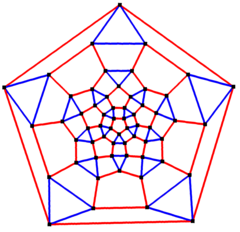Rhombicosidodecahedron
| Rhombicosidodecahedral graph | |
|---|---|

5-fold symmetry
|
|
| Vertices | 60 |
| Edges | 120 |
| Automorphisms | 120 |
| Properties | Quartic graph, Hamiltonian, regular |
In geometry, the rhombicosidodecahedron, or small rhombicosidodecahedron, is an Archimedean solid, one of thirteen convex isogonal nonprismatic solids constructed of two or more types of regular polygon faces.
It has 20 regular triangular faces, 30 square faces, 12 regular pentagonal faces, 60 vertices and 120 edges.
The name rhombicosidodecahedron refers to the fact that the 30 square faces lie in the same planes as the 30 faces of the rhombic triacontahedron which is dual to the icosidodecahedron.
It can also be called an expanded or cantellated dodecahedron or icosahedron, from truncation operations on either uniform polyhedron.
If you expand an icosahedron by moving the faces away from the origin the right amount, without changing the orientation or size of the faces, and do the same to its dual dodecahedron, and patch the square holes in the result, you get a rhombicosidodecahedron. Therefore, it has the same number of triangles as an icosahedron and the same number of pentagons as a dodecahedron, with a square for each edge of either.
The rhombicosidodecahedron shares the vertex arrangement with the small stellated truncated dodecahedron, and with the uniform compounds of six or twelve pentagrammic prisms.
...
Wikipedia
